Jun 2010
Lay-bys of the week:
Cape Cornwall and Lizard Point
Wednesday, 30 June, 2010. Filed under: Landscapes | Views & Scenery
What with the melée of tat and counterfeit Cornishness down the road at Lands End, Cape Cornwall doesn’t have to do much to impress, but it is very much the real thing, a wild spot in an increasingly crowded county. It is - separatist views notwithstanding - the only headland named as a cape in England or Wales (and, by a process of elimination, Cornwall) and is vastly superior to its commercial counterpart down the coast. Indeed, until 1801, when the Ordnance Survey came along, it was assumed to be the most westerly point in Britain, a runner-up status that has at least shielded it from the kind of unwanted attention that is focussed upon Lands End.
The text book definition of a cape, by the way, is a promontory where two major bodies of water meet - in this case the Atlantic and St George's Channel. Since those nineteenth century OS men declared Lands End as further out in the ocean it is arguably where the waters meet rather than Cape Cornwall, but the name stuck anyway.
View Larger Map
Meanwhile, there’s no such controversy about Lizard Point, mainland Britain’s most southerly spot. There’s a National Trust car park there as well and a bonus collection of sheds that sell souvenirs carved from the local rock. This rock, serpentine, is metamorphic in origin, 400 million years or so old, and an excellent example of a bit of oceanic crust that has unaccountably slid over the top of a piece of continent (it almost always slides under when the two collide).
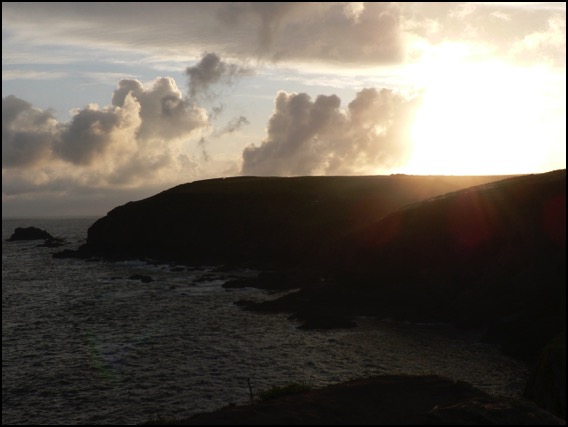
You might like a cup of tea, while you contemplate that and, besides one of the souvenir sheds, lies the cafe with the best view in all of Cornwall (below). It’s always busy in the season and it’s always worth the wait. You may even be fortunate enough to see a couple of Cornish Choughs wheeling in the sky, failing that you can stare at the cliff that rings with the sound of Jackdaws and Kittiwake and hope to catch a glimpse of a Peregrine or two.
View Larger Map
The text book definition of a cape, by the way, is a promontory where two major bodies of water meet - in this case the Atlantic and St George's Channel. Since those nineteenth century OS men declared Lands End as further out in the ocean it is arguably where the waters meet rather than Cape Cornwall, but the name stuck anyway.
View Larger Map
Meanwhile, there’s no such controversy about Lizard Point, mainland Britain’s most southerly spot. There’s a National Trust car park there as well and a bonus collection of sheds that sell souvenirs carved from the local rock. This rock, serpentine, is metamorphic in origin, 400 million years or so old, and an excellent example of a bit of oceanic crust that has unaccountably slid over the top of a piece of continent (it almost always slides under when the two collide).

You might like a cup of tea, while you contemplate that and, besides one of the souvenir sheds, lies the cafe with the best view in all of Cornwall (below). It’s always busy in the season and it’s always worth the wait. You may even be fortunate enough to see a couple of Cornish Choughs wheeling in the sky, failing that you can stare at the cliff that rings with the sound of Jackdaws and Kittiwake and hope to catch a glimpse of a Peregrine or two.
View Larger Map
Comments
Beautiful geology
Monday, 28 June, 2010. Filed under: Lie of the Land
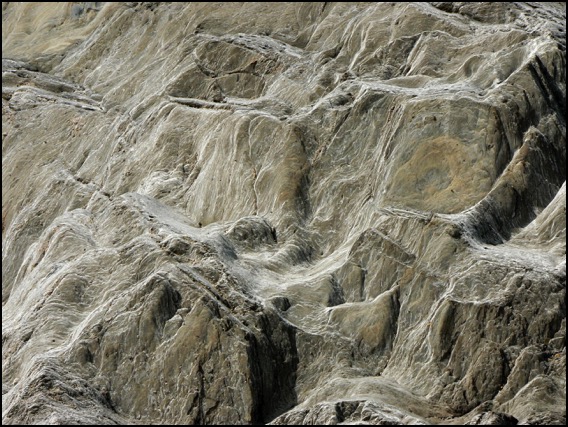
On the face of it, slate is not an inspiring material. Roofs built from it cover concentric rings of brick-built Victorian suburbs around most of our larger cities while the holes in the ground that were left behind are - I would venture - only really at their most thrilling when you are unfortunate enough to be plummeting to a brutal and untidy death at the foot of one.
But look at these pictures of not just any-old slate but, rather, some fairly poor-quality slate (in terms of building materials, that is) on the coast of South Devon. This particular outcrop has probably been attacked by waves twice daily for thousands of years and has started to acquire something of a liquid texture as if mimicking its tormentor.
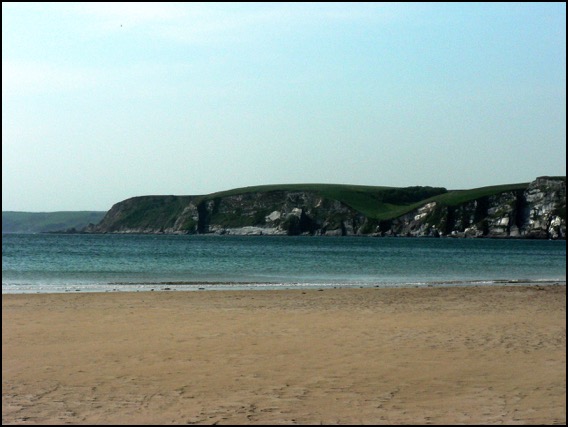
When viewed from a distance, the cliffs formed from this poor slate, which has a lustrous glaze about it when you find one of its pebbles on the beach, gleam in low sunshine like a washing line in a detergent advertisement. And this is all just a rather poor-quality Devonian slate.
Monstrous Carbuncle
I like Dorset - as mentioned in this week’s Lay-by of the Week, it is where a lot of the ideas for The Lie of the Land came from and it is a county that seems to have as many different facets as it has market towns.
But one of those towns – and not just any old market town, but Dorset’s county town – will never be the same again. For Dorchester has been tainted by its association with the monstrous carbuncle that is HRH Prince Charles’ Poundbury or, to give it a name accidentally arrived at in a Freudian slip of the tongue, Poundland.
View Monstrous Carbuncle in a larger map
This grotesque and repulsive display of architectural pus sits on the eastern horizon as you approach Dorchester from the west. The awful buildings infect the surrounding landscape with their weak-minded parody of a passing resemblance to a rough similarity to a half-remembered Tuscan hill-top village. Who-ever presided over this inferior and wholly unaesthetic effort should be shot through the lungs with high-velocity 2H pencils.
Some of Poundbury is well-executed, even if it is obviously the work of a cobwebbed mind. While the Duke of Cornwall proclaims his love of traditional vernacular architecture and actually has interesting and useful ideas about the sustainability of communities, his biggest showcase looks like a malformed bleb from the side of the A35.
But one of those towns – and not just any old market town, but Dorset’s county town – will never be the same again. For Dorchester has been tainted by its association with the monstrous carbuncle that is HRH Prince Charles’ Poundbury or, to give it a name accidentally arrived at in a Freudian slip of the tongue, Poundland.
View Monstrous Carbuncle in a larger map
This grotesque and repulsive display of architectural pus sits on the eastern horizon as you approach Dorchester from the west. The awful buildings infect the surrounding landscape with their weak-minded parody of a passing resemblance to a rough similarity to a half-remembered Tuscan hill-top village. Who-ever presided over this inferior and wholly unaesthetic effort should be shot through the lungs with high-velocity 2H pencils.
Some of Poundbury is well-executed, even if it is obviously the work of a cobwebbed mind. While the Duke of Cornwall proclaims his love of traditional vernacular architecture and actually has interesting and useful ideas about the sustainability of communities, his biggest showcase looks like a malformed bleb from the side of the A35.
Lay-by of the week: Askerswell from the A35
This week I can tie three loose ends and write not only about lay-bys, but also the Dorset landscape and the road trip that triggered me into writing The Lie of the Land in the first place.
View Larger Map
One bright and crisp winters day a short breath after Christmas, we were driving through Dorset as we made our way back from Cornwall. The journey was quite familiar to me and I had never given it much thought. A couple of years before, I had come the closest to thinking deeply about travel when two friends and I covered the same ground as part of an epic, 15 mph journey across England in an electric milk float but, crucially we had picked a different route for this stretch.
I was on the A35, a murderously busy road we had escaped from while on the float - a quick turn-off that happened to land us in Arcadia, an enchanted valley near Little Bredy trapped somewhere between dusk and the early 1950s. It was the encapsulation of pastoral beauty and I will remember the scene for ever.
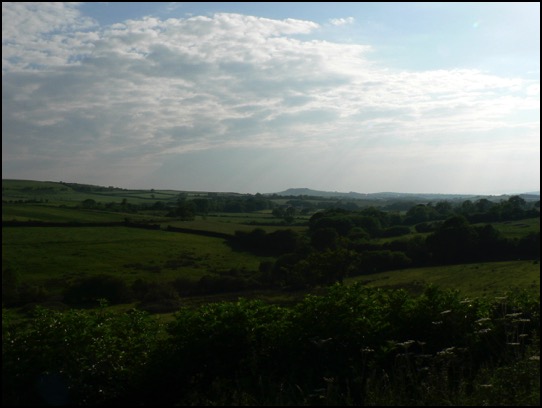
As so often happens in Britain though, by catching one thing, you miss another and the A35 - for all its homicidal ways - is the scene of something on a par with our Dorset Arcadia but in a different way. The stretch of it we avoided, between Dorchester and Bridport, affords awe-inspiring views of the lumpy, bumpy Dorsetshire hills, the festival of buxom hummocks that made it into the introduction to The Lie of the Land.

As ever, all attempts to capture such grandeur on a soul-less semiconductor fail miserably. I’ve taken my version of the Google Street View, but the best stuff is on the other side of the road when the road reaches its height and the views over the Dorset coast are breathtaking. You really have to see the view for yourself.
View Larger Map
One bright and crisp winters day a short breath after Christmas, we were driving through Dorset as we made our way back from Cornwall. The journey was quite familiar to me and I had never given it much thought. A couple of years before, I had come the closest to thinking deeply about travel when two friends and I covered the same ground as part of an epic, 15 mph journey across England in an electric milk float but, crucially we had picked a different route for this stretch.
I was on the A35, a murderously busy road we had escaped from while on the float - a quick turn-off that happened to land us in Arcadia, an enchanted valley near Little Bredy trapped somewhere between dusk and the early 1950s. It was the encapsulation of pastoral beauty and I will remember the scene for ever.

As so often happens in Britain though, by catching one thing, you miss another and the A35 - for all its homicidal ways - is the scene of something on a par with our Dorset Arcadia but in a different way. The stretch of it we avoided, between Dorchester and Bridport, affords awe-inspiring views of the lumpy, bumpy Dorsetshire hills, the festival of buxom hummocks that made it into the introduction to The Lie of the Land.

As ever, all attempts to capture such grandeur on a soul-less semiconductor fail miserably. I’ve taken my version of the Google Street View, but the best stuff is on the other side of the road when the road reaches its height and the views over the Dorset coast are breathtaking. You really have to see the view for yourself.
Welcome...
Wednesday, 16 June, 2010. Filed under: Lie of the Land
The British Landscape Club is featured on the Guardian website today in the form of a small slideshow of some of the oldest bits of Britain.

A big welcome to you if you have discovered us via the Guardian and please consider joining the BLC. There’s at least one good reason and that is that it’s completely free and there’s also a rather fetching and free badge. No catches, just tell us where to send it and we will pop in a small sampler of Chapter 1 of The Lie of the Land. That’s it. No hard sell - just relax and enjoy the view.
Join the BLC for free.

A big welcome to you if you have discovered us via the Guardian and please consider joining the BLC. There’s at least one good reason and that is that it’s completely free and there’s also a rather fetching and free badge. No catches, just tell us where to send it and we will pop in a small sampler of Chapter 1 of The Lie of the Land. That’s it. No hard sell - just relax and enjoy the view.
Join the BLC for free.
Lay-by of the week: Danebury hillfort
Tuesday, 08 June, 2010. Filed under: Landscapes | Views & Scenery
This week the BLC gets out of the car and goes for a short stroll up a magnificent hill in Hampshire.
View Larger Map
Danebury is a magnificent Iron Age hillfort a few miles north of Stockbridge. There are two car-parks, the lower of which is clearly visible from the Google Street View car, but visitors can make their way further up the drive to a second parking area partially under the cover of trees. It’s then a short, moderately stretching walk (we did it with an off-roading pram, its occupant and an additional toddler on a hot day, so it obviously isn’t that difficult) up the hill to a large complex of banks and ditches. The outer banks are now topped by beech trees and surround a village-size area of almost level ground, perfect for kite flying and exploration.
The view from the Ordnance Survey trig point is amazing and well worth the walk up the hill.

View Larger Map
Danebury is a magnificent Iron Age hillfort a few miles north of Stockbridge. There are two car-parks, the lower of which is clearly visible from the Google Street View car, but visitors can make their way further up the drive to a second parking area partially under the cover of trees. It’s then a short, moderately stretching walk (we did it with an off-roading pram, its occupant and an additional toddler on a hot day, so it obviously isn’t that difficult) up the hill to a large complex of banks and ditches. The outer banks are now topped by beech trees and surround a village-size area of almost level ground, perfect for kite flying and exploration.
The view from the Ordnance Survey trig point is amazing and well worth the walk up the hill.

The Lie of the Land is launched
Friday, 04 June, 2010. Filed under: Lie of the Land
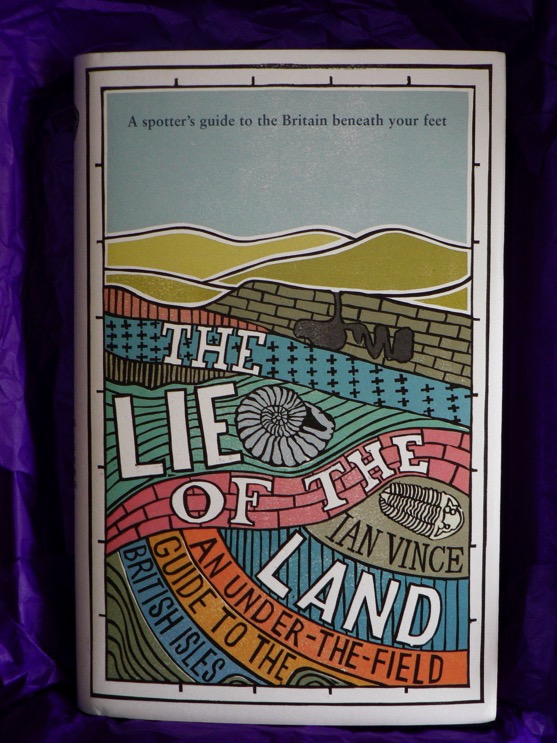 Today, Friday June 4, is the official publication date of The Lie of the Land, the BLC’s unofficial under-the-field guide to the British landscape, as written by Ian Vince The Lie of the Land was written over the course of 14 months during 2009 and 2010 as Ian travelled back and forth across Britain to tell the truly extraordinary story of how our beautiful landscape was formed.
Today, Friday June 4, is the official publication date of The Lie of the Land, the BLC’s unofficial under-the-field guide to the British landscape, as written by Ian Vince The Lie of the Land was written over the course of 14 months during 2009 and 2010 as Ian travelled back and forth across Britain to tell the truly extraordinary story of how our beautiful landscape was formed.Needless to say, it is available in all good bookshops, as well as their online counterparts, Amazon, Waterstones and Pickabook. Ian would obviously love you to go and buy it in your droves but not just so that he can write something along similar lines for the next one, but also because the book’s message is all about celebrating the awesomely fascinating landscapes we are lucky enough to have in Britain.
The Lie of the Land is available…
Wednesday, 02 June, 2010. Filed under: Lie of the Land

The Lie of the Land is officially published on the June 4 but online retailers including Amazon, Waterstones and Pickabook are now dispatching copies so you can have it in time for official pub. day (this is the day - among many others - that you can find authors in the pub).
